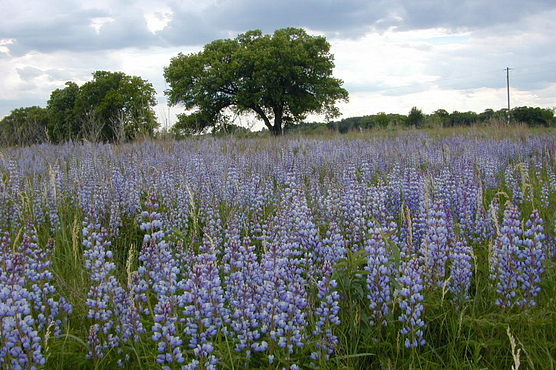Identification tips and habitat
Karner blue butterfly
The Karner blue butterfly, Lycaeides melissa samuelis, is in the Lycaenidae (gossamer-winged butterfly) family.
Size and markings
The adult Karner blue butterfly is about the size of a nickel — with a wingspan of about an inch — and it can be identified by the bands of orange spots on the underside edge of its wings. The top sides of the male's wings are deep sky blue, while those of the female are darker blue and brown with orange spots on the edges of both hind wings. The dorsal sides of the male's wings are deep sky blue with black margins bordered by a white band, while those of the female are darker blue and brown with orange crescents on the edges of both hind wings.
Both sexes can be identified by the bands of orange crescents on the undersides of both the fore and hind wings. Karner blues are the only small blue butterflies that have orange crescents on the undersides of both the fore- and hind wings. Positive identification of a Karner blue requires that you observe these orange crescents on the underwings of the butterfly.
Comparing Karner blue with other blue butterflies
Wing comparison
| Male | Female | Underwing | |
|---|---|---|---|
| Karner blue | |||
| Eastern-tailed blue | |||
| Spring azure | (photo not available) | (photo not available) | |
| Silvery blue |
Descriptions, flight period and habitat comparison
| Underwing description | Dorsal wing description | Flight period | Habitat | |
|---|---|---|---|---|
| Karner blue | Orange crescents along the margins of both the fore and hind underwings. | Male's dorsal side is light blue with black margins bordered by a white band. The dorsal side of the female is a dark blue to brown with orange crescents along edges of hind wings. | Two flight periods, one beginning in late May and the second in mid-July. | Associated with sand and brush prairies, and oak barrens where wild lupine is present. |
| Eastern-tailed blue | Two orange crescents on the underwings. | Orange crescents on edges of the dorsal side of both hind wings. A key feature is the presence of a small tail on each of the hind wings. | Three broods, starting in April and continuing through October. | It can occur in Karner blue habitat but also uses a variety of habitats including mesic prairies, wetlands and old fields. |
| Spring azure | No orange crescents. Underwings are light blue or gray with irregular black spots. | The dorsal view looks very similar to male Karner blue. | Prominent in early spring and persists throughout the growing season. | Associated with woodlands, fields and wetlands. |
| Silvery blue | No orange crescents. Underwings are gray with a row of black dots. | No orange crescents. Underwings are gray with a row of black dots. | Present at the same time as Karner blue first flight. | Found near open woodlands and open areas. |
Signs of Karner blue
Habitat

The Karner blue butterfly's habitat once ranged from Minnesota to Maine and into Canada. Habitat loss, destruction and fragmentation primarily due to natural succession, agriculture and residential and commercial development caused the decline. Outside of Wisconsin, the Karner blue has been reduced to small populations in Indiana, Michigan, Minnesota, New Hampshire and New York. Karner blues are considered extirpated in Massachusetts, Pennsylvania, Ohio and Ontario.
In Wisconsin, the Karner blue butterfly usually occupies open barrens, savannas and prairies that contain wild lupine. This plant is widespread in Wisconsin’s central and northwest sands, and the pale green caterpillar of the Karner blue feeds exclusively on the leaves of wild lupine. Karners can also be found in other habitats, including roadsides, utility right-of-ways or other areas that are maintained in an open early successional stage. These corridors can provide an important link between larger habitat areas and encourage dispersal and genetic diversity.
















